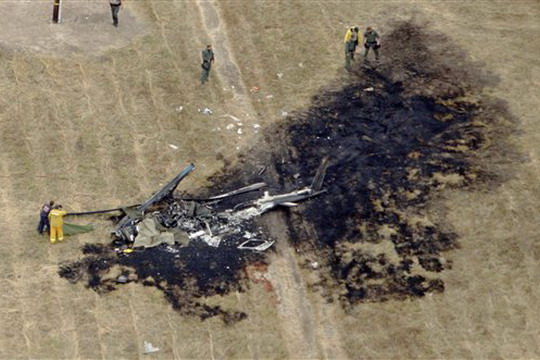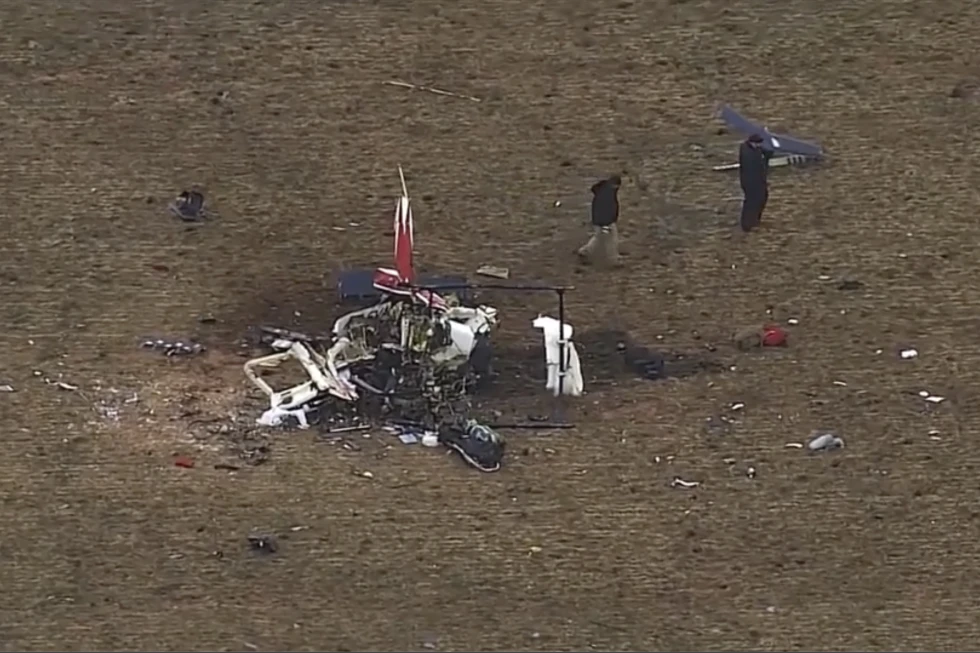The tragic crash of a medical helicopter in western Oklahoma, resulting in the loss of three lives, has raised serious concerns about the safety of flight operations in the region.
The preliminary report released by the National Transportation Safety Board (NTSB) has revealed a disturbing finding – a dead goose was discovered in part of the helicopter’s flight control system.
This discovery has prompted a closer examination of the circumstances leading up to the crash and has left many questioning the potential risks posed by wildlife in the vicinity of flight paths.
The NTSB’s preliminary report does not offer a suspected cause for the crash, but the presence of a goose in the helicopter’s flight control system is a troubling detail that cannot be overlooked.
Additionally, the discovery of other geese in the debris field further underscores the potential impact of wildlife on aviation safety.
As investigators delve into the details surrounding this tragic incident, it is imperative that a thorough analysis be conducted to determine the extent to which wildlife may have played a role in the crash.
The NTSB has indicated that a report on the probable cause of the crash could take up to two years to complete.
While this timeframe may seem extensive, it reflects the meticulous nature of the investigation process and the commitment to uncovering the truth behind aviation accidents.
As the investigation progresses, it is crucial that all factors, including the potential influence of wildlife, are carefully considered in order to prevent similar tragedies from occurring in the future.
The presence of wildlife in and around flight paths poses a significant challenge for aviation safety. While measures are in place to mitigate the risk of bird strikes, the incident in Oklahoma serves as a stark reminder of the potential consequences when wildlife and aircraft intersect.
As such, it is imperative that aviation authorities and wildlife management agencies work collaboratively to develop strategies that enhance the safety of flight operations while also preserving the natural habitats of wildlife.
In light of this tragic event, it is essential for aviation stakeholders to reevaluate existing protocols and procedures related to wildlife management.
This includes conducting thorough risk assessments of flight paths, implementing advanced detection and deterrent systems, and enhancing pilot training on wildlife avoidance strategies.
Furthermore, collaboration between aviation and wildlife management entities is crucial in order to foster a comprehensive approach to mitigating the risks associated with wildlife encounters during flight operations.
The crash of the medical helicopter in Oklahoma has undoubtedly sent shockwaves through the aviation community and has underscored the critical importance of addressing the potential hazards posed by wildlife.
As the NTSB’s investigation into the probable cause of the crash unfolds, it is imperative that comprehensive measures are taken to prevent similar incidents in the future.
By prioritizing the safety of flight operations and implementing proactive wildlife management strategies, the aviation industry can strive to minimize the risks associated with wildlife encounters and uphold the highest standards of safety for all those who take to the skies.
The tragic helicopter crash that occurred on January 20th in a pasture near Hydro, Oklahoma has left a deep impact on the community and the aviation industry as a whole.
The helicopter, which was operated by Air Evac Lifeteam, was returning to Weatherford after transporting a patient to an Oklahoma City hospital when the accident occurred.
The pilot and both crew members, a flight nurse and a paramedic, lost their lives in the crash, leaving behind grieving families, friends, and colleagues.
This devastating incident serves as a stark reminder of the inherent risks associated with air medical transport and the importance of prioritizing safety in all aspects of aviation.
The loss of three dedicated and skilled professionals has undoubtedly sent shockwaves through the medical and aviation communities, prompting a renewed focus on the implementation of stringent safety protocols and measures to prevent similar tragedies in the future.
In the aftermath of the crash, an investigation was launched to determine the cause of the accident and to identify any contributing factors.
It is crucial that a thorough and comprehensive analysis be conducted to shed light on the circumstances surrounding the crash and to ascertain whether any lapses in safety procedures or mechanical failures played a role in the tragedy.
The findings of the investigation will not only provide much-needed closure to the families of the victims but also offer valuable insights that can be used to enhance safety standards within the air medical transport industry.
Furthermore, the helicopter crash near Hydro has underscored the inherent risks and challenges faced by air medical transport personnel on a daily basis.
These dedicated professionals routinely put their lives on the line to provide critical care and medical assistance to patients in need, often operating in high-stress and demanding environments.
The loss of the pilot and crew members serves as a poignant reminder of the selfless sacrifices made by these individuals in the line of duty and the profound impact they have on the lives of those they serve.
In the wake of this tragedy, it is imperative that the aviation and medical communities come together to honor the memory of the fallen pilot and crew members and to support their families during this difficult time.
Additionally, it is incumbent upon industry stakeholders to recommit themselves to the highest standards of safety and operational excellence, ensuring that every measure is taken to safeguard the lives of air medical transport personnel and the patients they serve.
As we mourn the loss of the pilot and crew members who perished in the helicopter crash near Hydro, we must also reflect on the invaluable contributions they made to the field of air medical transport and the lasting impact they had on the lives of those they touched.
Their dedication, professionalism, and unwavering commitment to saving lives will forever be remembered and cherished by their colleagues, patients, and the community at large.
In conclusion, the helicopter crash near Hydro, Oklahoma has sent shockwaves through the aviation and medical communities, prompting a renewed focus on safety and operational excellence within the air medical transport industry.

The loss of the pilot and crew members serves as a sobering reminder of the inherent risks and sacrifices associated with air medical transport, and it is incumbent upon industry stakeholders to honor their memory by prioritizing safety and implementing measures to prevent similar tragedies in the future.
As we mourn the loss of these dedicated professionals, we must also celebrate their legacy and the profound impact they had on the lives of those they served.
